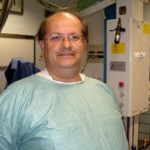Interventional cardiology is a type of minimally invasive diagnostic and therapeutic procedure for blood vessels and the heart. All surgical manipulations are performed through a small puncture in a vein or artery. A thin tube with a specialized tip – a catheter – is inserted into the vessel. Most interventional procedures are performed through a catheter.
At San Donato, doctors perform the following interventions:
- Coronary angiography;
- Angioplasty of peripheral vessels;
- Plastic surgery of carotid arteries;
- Replacement of mitral and aortic valves;
- Plastic surgery of coronary arteries of the heart;
- Stent placement;
- Reconstruction of aortic and mitral valves.
Previously, such operations were performed on the open heart and blood vessels. This increased the risk of infection, bleeding, and death in the postoperative period.
Each year, more than 6,000 patients are treated in the department. Thanks to advanced equipment, the clinic successfully treats patients with acute and life-threatening conditions, such as myocardial infarction.
Center Equipment and Diagnostics
The primary cause of myocardial infarction is insufficient blood supply to the heart muscle. Blood supplies the heart through the coronary arteries. Spasm or atherosclerosis of these vessels leads to angina or heart attack.
San Donato uses the following technologies for comprehensive coronary artery diagnostics:
- Optical coherence tomography (OCT);
- Intravascular ultrasound (IVUS);
- Functional flow reserve (FFR).
These methods allow doctors to assess critical parameters such as vessel wall thickness, presence of calcification, and the degree of vessel patency.
TAVI Procedure
Some diseases are accompanied by narrowing of the aortic valve opening, known as aortic stenosis. Severe stenosis interferes with the normal flow of blood from the left ventricle to the aorta. This leads to life-threatening conditions and even death.
A modern treatment approach is Transcatheter Aortic Valve Implantation (TAVI). During the procedure, the surgeon delivers the valve to the heart in a compressed form through the femoral or subclavian artery. Once inside the heart, the valve opens and replaces the damaged aortic valve. The entire process is carried out with ultrasound or X-ray navigation.
Thus, the entire procedure takes place without a single incision on the body. This allows the surgery to be performed on high-risk patients, as well as on elderly people over 85 years of age.
San Donato uses advanced biocompatible valve prostheses, including Symetis, Evolut PRO, Portico, and Sapien 3.



